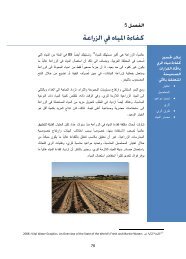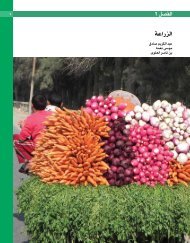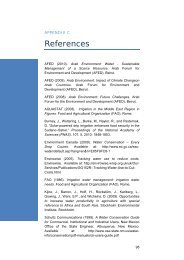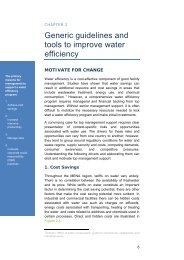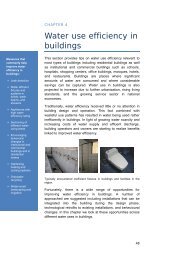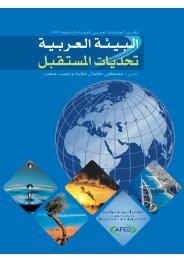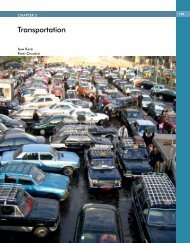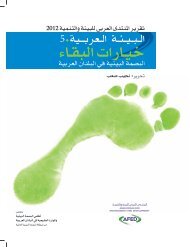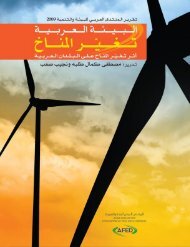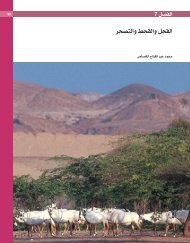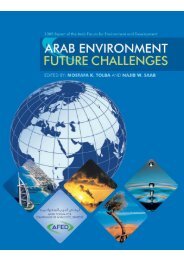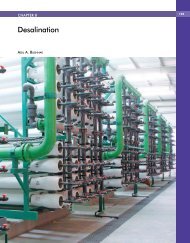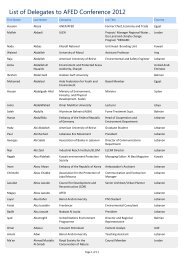Impact of Climate Change on Arab Countries - (IPCC) - Working ...
Impact of Climate Change on Arab Countries - (IPCC) - Working ...
Impact of Climate Change on Arab Countries - (IPCC) - Working ...
You also want an ePaper? Increase the reach of your titles
YUMPU automatically turns print PDFs into web optimized ePapers that Google loves.
ARAB ENVIRONMENT: CLIMATE CHANGE 69<br />
ti<strong>on</strong>, in c<strong>on</strong>juncti<strong>on</strong> with changes in rainfall and<br />
temperature, is likely to have significant impacts<br />
<strong>on</strong> grasslands and rangelands, with producti<strong>on</strong><br />
increases in humid temperate grasslands, but<br />
decreases in arid and semi-arid regi<strong>on</strong>s (<strong>IPCC</strong>,<br />
2007a).<br />
Animal requirements for crude proteins from pastures<br />
range from 7 to 8% <str<strong>on</strong>g>of</str<strong>on</strong>g> ingested dry matter,<br />
up to 24% for the highest-producing dairy cows.<br />
In c<strong>on</strong>diti<strong>on</strong>s <str<strong>on</strong>g>of</str<strong>on</strong>g> very low Nitrogen status in pasture<br />
ranges under arid and semi-arid c<strong>on</strong>diti<strong>on</strong>s,<br />
possible reducti<strong>on</strong>s in crude proteins under elevated<br />
CO 2 may put a system into a sub-maintenance<br />
level for animal performance (Milchunas et al.,<br />
2005). The decline under elevated CO 2 levels<br />
(Polley et al., 2003) <str<strong>on</strong>g>of</str<strong>on</strong>g> C4 grasses, which are a less<br />
nutritious food resource than C3 (Ehleringer et<br />
al., 2002), may also compensate for the reduced<br />
protein c<strong>on</strong>tent under elevated CO 2 . Generally,<br />
thermal stress reduces productivity and c<strong>on</strong>cepti<strong>on</strong><br />
rates, and is potentially life-threatening to<br />
livestock. Because ingesti<strong>on</strong> <str<strong>on</strong>g>of</str<strong>on</strong>g> food and feed is<br />
directly related to heat producti<strong>on</strong>, any decline in<br />
feed intake and/or energy density <str<strong>on</strong>g>of</str<strong>on</strong>g> the diet will<br />
reduce the amount <str<strong>on</strong>g>of</str<strong>on</strong>g> heat that needs to be dissipated<br />
by the animal. Mader and Davis (2004)<br />
c<strong>on</strong>firm that the <strong>on</strong>set <str<strong>on</strong>g>of</str<strong>on</strong>g> a thermal challenge<br />
<str<strong>on</strong>g>of</str<strong>on</strong>g>ten results in declines in physical activity with<br />
associated declines in eating and grazing (for<br />
ruminants and other herbivores) activities. New<br />
models <str<strong>on</strong>g>of</str<strong>on</strong>g> animal energetics and nutriti<strong>on</strong><br />
(Pars<strong>on</strong>s et al., 2001) have shown that high temperatures<br />
put a ceiling <strong>on</strong> dairy milk yield irrespective<br />
<str<strong>on</strong>g>of</str<strong>on</strong>g> feed intake. Increases in air temperature<br />
and/or humidity have the potential to affect<br />
c<strong>on</strong>cepti<strong>on</strong> rates <str<strong>on</strong>g>of</str<strong>on</strong>g> domestic animals not adapted<br />
to those c<strong>on</strong>diti<strong>on</strong>s. This is particularly the case<br />
for cattle, in which the primary breeding seas<strong>on</strong><br />
occurs in spring and summer m<strong>on</strong>ths. Amunds<strong>on</strong><br />
et al. (2005) reported declines in c<strong>on</strong>cepti<strong>on</strong> rates<br />
<str<strong>on</strong>g>of</str<strong>on</strong>g> cattle for temperatures above 23.4 º C and at<br />
high thermal heat index.<br />
Moreover, impacts <strong>on</strong> animal productivity due to<br />
increased variability in weather patterns will likely<br />
be far greater than effects associated with the<br />
average change in climatic c<strong>on</strong>diti<strong>on</strong>s. Lack <str<strong>on</strong>g>of</str<strong>on</strong>g><br />
prior c<strong>on</strong>diti<strong>on</strong>ing to weather events most <str<strong>on</strong>g>of</str<strong>on</strong>g>ten<br />
results in catastrophic losses in c<strong>on</strong>fined cattle<br />
feedlots (Hahn et al., 2001), with ec<strong>on</strong>omic losses<br />
from reduced cattle performance exceeding<br />
those associated with cattle death losses severalfold<br />
(Mader, 2003). In dry regi<strong>on</strong>s, there are risks<br />
that severe vegetati<strong>on</strong> degenerati<strong>on</strong> leads to positive<br />
feedbacks between soil degradati<strong>on</strong> and<br />
reduced vegetati<strong>on</strong> and rainfall, with corresp<strong>on</strong>ding<br />
losses <str<strong>on</strong>g>of</str<strong>on</strong>g> pastoral areas and farmlands<br />
(Zheng et al., 2002). A number <str<strong>on</strong>g>of</str<strong>on</strong>g> studies in<br />
Africa (Batima, 2003) show a str<strong>on</strong>g relati<strong>on</strong>ship<br />
between droughts and animal death. Projected<br />
temperature increases, combined with reduced<br />
precipitati<strong>on</strong> in North Africa would lead to<br />
increased loss <str<strong>on</strong>g>of</str<strong>on</strong>g> domestic herbivores during<br />
extreme events in drought-pr<strong>on</strong>e areas. With<br />
increased heat stress in the future, water requirements<br />
for livestock will increase significantly<br />
compared to current c<strong>on</strong>diti<strong>on</strong>s, so that overgrazing<br />
near watering points is likely to expand<br />
(Batima et al., 2005).<br />
V. IMPACT OF CLIMATE CHANGE<br />
ON FISHING AND AQUACULTURE<br />
Aquaculture resembles terrestrial animal husbandry<br />
and therefore shares many <str<strong>on</strong>g>of</str<strong>on</strong>g> the vulnerabilities<br />
and adaptati<strong>on</strong>s to climate change with<br />
that sector. Similarities between aquaculture and<br />
terrestrial animal husbandry include ownership,<br />
c<strong>on</strong>trol <str<strong>on</strong>g>of</str<strong>on</strong>g> inputs, diseases and predators, and use<br />
<str<strong>on</strong>g>of</str<strong>on</strong>g> land and water. Some aquaculture, particularly<br />
<str<strong>on</strong>g>of</str<strong>on</strong>g> plants, depends <strong>on</strong> naturally occurring<br />
nutrients, but the rearing <str<strong>on</strong>g>of</str<strong>on</strong>g> fish usually requires<br />
the additi<strong>on</strong> <str<strong>on</strong>g>of</str<strong>on</strong>g> suitable food. Capture fisheries<br />
depend <strong>on</strong> the productivity <str<strong>on</strong>g>of</str<strong>on</strong>g> natural ecosystems<br />
and are therefore vulnerable to climate change<br />
induced changes affecting producti<strong>on</strong> in natural<br />
aquatic ecosystems.<br />
<strong>IPCC</strong> (2007a) reports a number <str<strong>on</strong>g>of</str<strong>on</strong>g> key negative<br />
impacts <str<strong>on</strong>g>of</str<strong>on</strong>g> climate change <strong>on</strong> aquaculture and<br />
freshwater fisheries, including (i) stress due to<br />
increased temperature and oxygen demand and<br />
increased acidity (lower pH); (ii) uncertain future<br />
water supply; (iii) extreme weather events; (iv)<br />
increased frequency <str<strong>on</strong>g>of</str<strong>on</strong>g> disease and toxic events; (v)<br />
sea level rise and c<strong>on</strong>flict <str<strong>on</strong>g>of</str<strong>on</strong>g> interest with coastal<br />
protecti<strong>on</strong> needs; and (vi) uncertain future supply<br />
<str<strong>on</strong>g>of</str<strong>on</strong>g> fishmeal and oils from capture fisheries.<br />
Positive impacts include increased growth rates<br />
and food c<strong>on</strong>versi<strong>on</strong> efficiencies, increased length<br />
<str<strong>on</strong>g>of</str<strong>on</strong>g> growing seas<strong>on</strong>, range expansi<strong>on</strong> and use <str<strong>on</strong>g>of</str<strong>on</strong>g><br />
new areas due to decreases in ice cover.<br />
Temperature increases may cause seas<strong>on</strong>al



